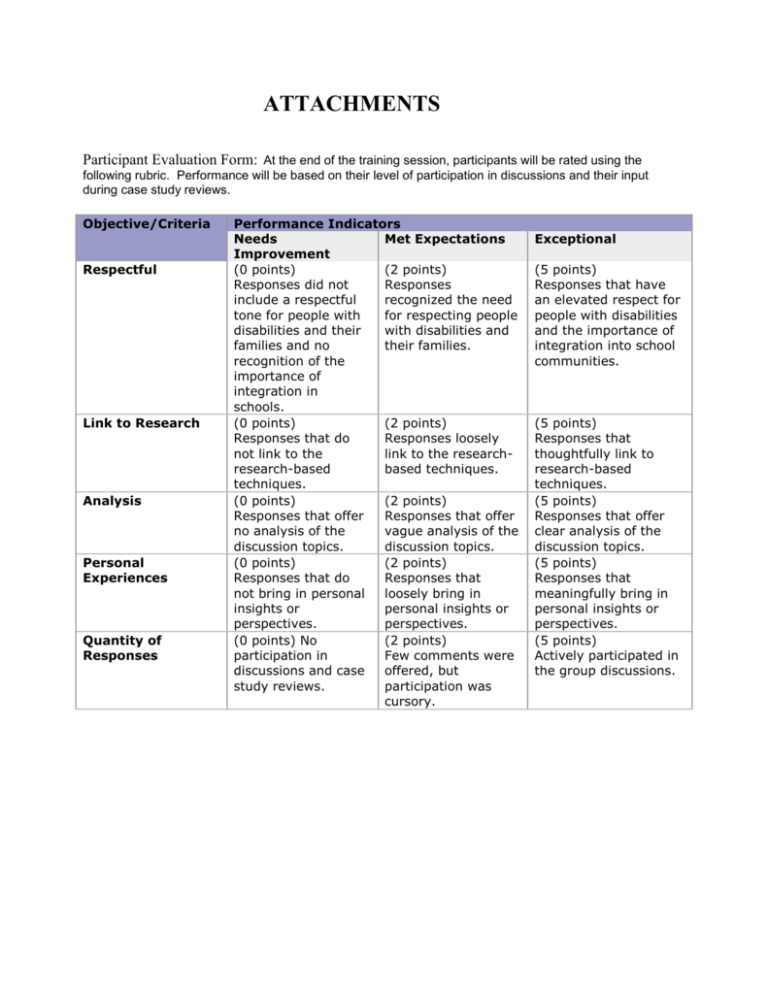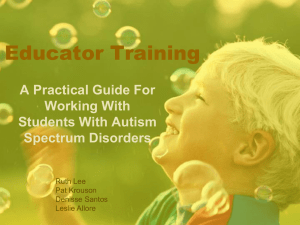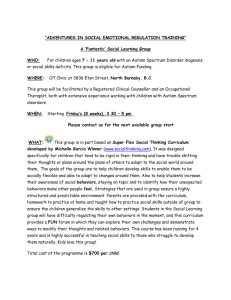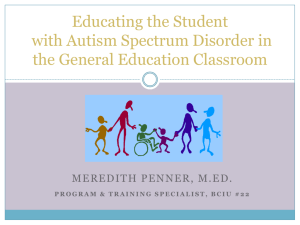1¾ « à
advertisement

ATTACHMENTS Participant Evaluation Form: At the end of the training session, participants will be rated using the following rubric. Performance will be based on their level of participation in discussions and their input during case study reviews. Objective/Criteria Respectful Link to Research Analysis Personal Experiences Quantity of Responses Performance Indicators Needs Met Expectations Improvement (0 points) (2 points) Responses did not Responses include a respectful recognized the need tone for people with for respecting people disabilities and their with disabilities and families and no their families. recognition of the importance of integration in schools. (0 points) (2 points) Responses that do Responses loosely not link to the link to the researchresearch-based based techniques. techniques. (0 points) (2 points) Responses that offer Responses that offer no analysis of the vague analysis of the discussion topics. discussion topics. (0 points) (2 points) Responses that do Responses that not bring in personal loosely bring in insights or personal insights or perspectives. perspectives. (0 points) No (2 points) participation in Few comments were discussions and case offered, but study reviews. participation was cursory. Exceptional (5 points) Responses that have an elevated respect for people with disabilities and the importance of integration into school communities. (5 points) Responses that thoughtfully link to research-based techniques. (5 points) Responses that offer clear analysis of the discussion topics. (5 points) Responses that meaningfully bring in personal insights or perspectives. (5 points) Actively participated in the group discussions. Participants will be asked to complete the following evaluation form in order to gain specific feedback on their experience and how the training can be refined. Please help us make this conference better next year by filling out this short questionnaire. You may turn in your questionnaire at the registration desk when you leave Items Please rate your overall satisfaction with the training. Please rate your overall satisfaction with the presentation style of the instructor. Please rate your overall satisfaction with the format of the conference (i.e. breaks, small group work, discussions). Please rate your overall satisfaction with the location of the training. Please rate the degree to which you felt the information will be directly applicable to students you serve. Please rate your satisfaction with the handouts and resources you were provided within the conference. Rating Categories Needs Improvement Met Expectations Exceptional Specific Plan for Delivering the Training: 1) Introduction of the presenter and participants with an overview of the training goals and outcomes. 2) Review of the Part 200 of the Regulations of the Commissioner of Education and Individuals with Disabilities Act (IDEA). Brief discussion of the history of the regulations and their impact on the delivery of services to students with Autism in the schools. A discussion of the importance of Least Restrictive Environments and the benefits of inclusion for students. 3) Overview of the DSM-IV Criteria Patterns of pervasive impairment across developmental domains. Viewed as a spectrum with varying levels of impairment across the areas of communication, cognition, socialization, motor and adaptive functioning. Diagnosis based on behavioral presentation. Autism Spectrum Disorders (ASD) Even within the same diagnosis, profiles are heterogeneous. Pervasive Developmental Disorders Autism - evidence of impairment prior to age three, social-communication impairments, pattern of restricted/repetitive play behavior, 50-60% are in the MR range; though cognitive profile can be quite uneven. Rett’s Syndrome - primarily girls, genetic test, decelerated head growth, motoric impairments, severe/profound MR, loss of functional hand use. •Childhood Disintegrative Disorder - regressive pattern, evidence of impairment after age three, increase risk of seizure activity, profound loss of language/social connectedness. Asperger’s Syndrome - no history of language and/or cognitive impairments, pragmatic deficits, poor peer relations, isolated interests and/or inflexible patterns of behavior, concrete thinking. Pervasive Developmental Disorder (Not Otherwise Specified) - patterns of delay in the social-communication domain, as well as within play behaviors, however, criteria for other PDD’s not met. 4) Etiology/Prevalence •More prevalent among males (4:1) •Organically-based disorder (disruption in the early pruning process - “over-connected”). •Genetic Risk •Etiology Unknown, though theories are proposed including impact of toxins in the environment, vaccines, diet, metal exposure, fertility treatments - none have been supported by the research. •Latest study conducted by the Institute of Medicine (IOM) of the National Academies supported previous findings that there is no link between vaccines and autism. •Misguided Immune System? is 1/700 for Asperger’s Syndrome, 15 per 10,000 for Autism. •1/150 for ASD’s overall. Prevalence is increasing dramatically. •Prevalence 5) Characteristics of ASD’s/Early Signs What are the early signs of Autism? •No babbling by 12 months. •No back and forth gesturing such as pointing, showing, reaching or waving by 12 months. •Decreased responsiveness to name. •No words by 16 months. •No two-word meaningful phrases by 24 months. •Lack of eye contact. •Failure to imitate verbal/non-verbal behaviors. •Any loss of speech, babbling or social skills. Current Research on Eye Gaze in Infants and Toddlers (Building Joint Attention = Theory of Mind). • Communication Patterns of Children with ASD •Asperger’s : Exceptional Language with noted impairments in understanding or attention to language. •Children with more impaired ASD can have significant expressive and receptive language impairments. •Decreased initiation of meaningful language. •Conversational Difficulties - lack of reciprocity. •Repetitive/idiosyncratic language. •Odd prosody, limited integration of gestures and eye contact. •Deficits in understanding non-verbal communication (theory of mind). Social Interaction Deficits •Lack of social referencing/ imitation. •Decreased joint attention/shared enjoyment. •Decreased range of affect. •Difficulties with taking the perspective of others - egocentric. •Difficulties with forming and maintaining friendships (may prefer adults to the exclusion of his/her peers). •Appear immature, naïve, lacking social insight (“pathetically childish”). •Yale Child Study Center - MRI imaging: Faces as Objects Restricted Interests/ Repetitive Behaviors •Restricted play interests, over-reliance on sensory play. •Insistence on sameness. •Over-reliance on non-functional routines. •Obsessive areas of interest (HFA/Asperger’s differential) •Perseverative questioning/ restricted topics. •Inflexibility within daily situations - transitional challenges. •Stereotyped body movements Related Challenges •Sensory Sensitivities (tactile, auditory, visual) •Self-regulatory challenges (emotional dysregulation, attentional needs, mood fluctuations, sleep disturbances, selective eating patterns). •Anxiety and compulsive patterns •Hyperactivity, Inattentiveness, Impulsivity •Disorganization/ Motor planning weakness •Medication can be helpful in treating some of these symptoms. 6) Evidence Based Instructional Methods/Interventions for Teaching Students with ASD. Overview of Methodologies/Philosophies Applied Behavioral Analysis/Structured Teaching TEACCH-Visually Based Instructional Strategies for Children with Autism Importance of Intensity and Direct Teaching Picture Exchange Communication Systems (PECS) “Best Practices” in Delivery of Instruction •Have a working knowledge of the receptive and expressive language needs of the student. Communication must always be supported. •Never assume cognitive skills are developing evenly. Review of the strengths of students on the spectrum with decoding/computation and less developed reading comprehension and inferential reasoning skills. •Visual Activity Schedules and Daily Visual Schedules to aid transitions and build independence. •Presets for new activities and transitions •Specify expectations (never assume they “fill in the blanks”) •Assistance with teaming projects (assign roles, coach peers) •Preteaching and Priming Academics and Social Interactions •Opportunities for Small Group/Individual Instruction •Using visual charts and pictures to illustrate concepts •Parallel teaching within the classroom •Visual cues evident on desk (personal schedules, activity lists, preset of behavioral expectations). •Visual timers to support attending and time on task. •Case Example reviewed that illustrates the implementation of visual supports and structured teaching for a lesson with an emphasis on differentiation of instruction. Increasing Social Understanding •Social Scripting •Social Indexing •The Hidden Curriculum •Social Stories (Carol Gray) •The Five Point Scale (Kari Dunn Buron) •Friendship Development •Peer Networks (Peer Network Project) •Video-taped feedback (review of current research “Best Practices” in enhancing communication for students on the spectrum Recognition that behavior is communication Understanding the value of communicative intent (i.e. use of eye gaze, picture supports, gestures and affect to communicate thought and intention). Building reciprocity (ability to take turns using non-verbal and/or verbal communication). Communication paradigms that help build understanding: i.e. the use of “first, then” language or using sentence starters as a means of building expressive language. The use of print and text to enhance communication and following of multi-step directives. Case Example of the use of visual supports to aid communication in children with Autism Spectrum Disorders. Specific visual examples will be provided. 7) Behavior Management and Positive Behavioral Supports Positive Behavioral Supports: Discussion of the importance of analyzing behaviors to determine motivation and patterns that may contribute to maladaptive behaviors. Data collection methods (ABC charts, scatter plots) to gain insight into the antecedents and potential reinforcers that contribute to behavioral patterns. Case example of the use of the Motivation Assessment Scale (Durand and Crimmins) Communicative Intent of Behavior: Recognition that maladaptive behaviors are often a means of communicating a need. Stress importance of teaching adaptive communication as a replacement. •“I need a break” • “It’s too loud in here” •“I need help” • “Let’s play” Sensory Overload: Children with ASD can be more sensitive to sensory input and this requires careful review when evaluating behavioral needs. •Children with ASD’s have sensory sensitivities/cravings that interfere with social and learning activities. •Recognize the sensory patterns. •Provide related experiences that “meet the need” (I.e. mouthing objects, frequent touching, restlessness). •Provide breaks or “on the sideline” experiences for kids who become overstimulated. Self-Regulation Challenges related to ASD: •Become agitated and/or highly anxious when the world does not make sense. •Highly directive behaviors (keep things the same, protect order, reduce negative emotions). •Very few coping strategies = meltdowns! Providing Self-Regulation Strategies •Provide the self-talk we want them to use (“when I get upset….”). •Picture and visual formats (“my plan”) •Emotional barometer - not just all or nothing (practice in “real life” settings) •Decompression area - access to sensory experiences to calm. Executive Function Challenges •Need to seek sameness is grounded in their challenges with organizing novel information (transitions, new settings, CHANGE!). •Help to organize info. Ahead of time by providing advanced organizers. •Visual Schedules, First-then routines, Activity Schedules, Pictures of setting with short social story. Time Timers. Social Stories: Discussion of the importance of developing social stories as a means of teaching social/adaptive skills. Also, the role of Social Stories in managing challenging behaviors will be reviewed. Social Stories Provide an Internal Script for better understanding Social Situations. - Written by parent/team/student - Perspective of the first person - “documentary” of the situation - Creative ways to present (pictures) - Select a skill, problem behavior or strength - Present one at a time on a regular basis Recipe for designing an effective Social Story - Descriptive Sentences - Perspective Taking Sentences - Directive Sentences - Affirmative Sentences Best Practices in Developing Social Stories: - Social Stories are not behavior plans - Avoid absolute terms (always, never) - Avoid negative terms (not, no) - More Descriptive and Perspective Taking Sentences - Building Social Understanding 8) Effective Collaboration, Resources and Supports Research on the importance of integrated teaming to support students on the spectrum in educational settings. Collaborative role sharing and the writing of integrated IEP goals that are implemented across settings, as well as across providers (special/general educators, speech/language therapists, occupational/physical therapists, social workers, psychologists, aides and administrators. Creating a school community that shares a common philosophy of including and education students on the spectrum. Brief review of the research on co teaching to support differentiation of instruction and modification of materials to meet New York State Learning Standards. Best practices for communicating with families. Strength-based focus when sharing information (not using the diagnosis as the lens for which to view the student, but rather sharing input that puts the child’s individual profile and needs in the forefront). Empathy-based communication that is respectful to families. Setting up team meetings that include parents to promote positive communication, sharing of strategies and common goal setting. Review of community resources/providers that can be helpful to families/students outside of the school setting (i.e. parent support groups, parent trainings, social/recreational events, medical providers, service coordination agencies).







